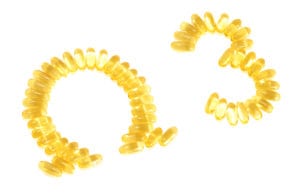Written by Jessica Patella, ND. The study results demonstrate an inverse association between omega-3 fatty acid consumption and subclinical inflammation for healthy older men.
 Cardiovascular disease is the leading cause of death among men and women in the United States 1. Omega-3 fatty acid consumption is recommended for the prevention of cardiovascular disease in those with a history of heart disease 2,3. Recent research evaluated omega-3 fatty acid intake in the diet and found an inverse relationship to markers for heart disease 2.
Cardiovascular disease is the leading cause of death among men and women in the United States 1. Omega-3 fatty acid consumption is recommended for the prevention of cardiovascular disease in those with a history of heart disease 2,3. Recent research evaluated omega-3 fatty acid intake in the diet and found an inverse relationship to markers for heart disease 2.
High sensitivity C-reactive protein (hsCRP), a marker of inflammation, has been found to predict the risk of cardiovascular events, including in those who are healthy 2,4,5. Chronic low-grade inflammation plays a role in atherosclerosis (hardening of the arteries), which eventually increases the risk of cardiovascular events, such as a heart attack or stroke 2,5. Since, hsCRP is a marker of inflammation, it can be used as a marker for the future risk of cardiovascular events 2.
Researchers examined the nutrition of adults and compared their daily omega-3 fatty acid intake to their daily energy intake to see if it was associated with chronic low-grade, also known as subclinical inflammation, as measured via hsCRP 2.
The research included 4804 healthy participants (2028 men and 2776 women) who were older than 60 years of age and from Korea. Subclinical inflammation was defined as hsCRP between 3-10mg/L. This range was chosen based on the American Heart Association and CDC findings that a high cardiovascular disease risk is associated with CRP levels in healthy adults above 3 mg/L, and a level above 10 mg/L is associated with serious trauma or disease 2,5,6.
Daily intake of omega-3 fatty acids was estimated using the 24-hour recall method (Can-Pro nutrient intake assessment software). The ratio of daily omega-3 fatty acid intake was calculated by dividing omega-3 kcal/day by the total calorie intake per day, then multiplying it by 100. The intakes were then categorized into four quartiles: Q1 <0.3%, Q2 0.3- <0.6%, Q3 0.6- <1.0% and Q4 greater than or equal to 1.0%.
The findings were as follows:
- The average omega-3 ratio in men without subclinical inflammation was 0.8% and 0.7% in men with subclinical inflammation (p-value =0.001).
- The prevalence of subclinical inflammation in males decreased with increasing quartiles of omega-3 fatty acid ratios (12.9%, 9.6%, 7.4% and 7.7%; p-value 0.033).
- Compared to Q1, the odds ratios (95%CI) for subclinical inflammation of Q2, Q3, and Q4 were 0.740 (0.465-1.177), 0.564 (0.341-0.930) and 0.549 (0.317-0.953) in males
- There was no difference in women’s omega-3 ratios and levels of inflammation.
These results demonstrate an inverse association between omega-3 fatty acid consumption and subclinical inflammation for healthy older men. Omega-3 fatty acids are known to have anti-inflammatory properties, which may account for part of these findings 2,7. Researchers proposed that the difference in results between men and women in this study could be because the healthy men had significantly higher CRP levels than the healthy women 2. The men were also more likely to smoke and heavily consume alcohol, compared to the women 2.
This was the first study to evaluate whether omega-3 fatty acid intake is associated with cardiovascular disease risk from subclinical inflammation in older healthy adults. Researchers suggested longitudinally designed studies to see if there is a prevention of cardiovascular events 2.
Source: Yang, Woojung, Jong Hun Lee, Jae-woo Lee, Yonghwan Kim, Ye-Seul Kim, Hyo-Sun You, and Hee-Taik Kang. “Increased Omega-3 Fatty Acid Intake Is Inversely Associated with Subclinical Inflammation in Healthy Elderly Men, Based on the 2015–2018 Korean National Health and Nutrition Examination Survey.” Nutrients 13, no. 2 (2021): 338.
© 2021 by the authors. Licensee MDPI, Basel, Switzerland. This article is an open access article distributed under the terms and conditions of the Creative Commons Attribution (CC BY) license (https:// creativecommons.org/licenses/by/ 4.0/)
Click here to read the full text study.
Posted June 16, 2021.
References:
- CDC. Heart Disease Facts. 2017; https://www.cdc.gov/heartdisease/facts.htm. Accessed May 14, 2021.
- Yang W, Lee JH, Lee JW, et al. Increased Omega-3 Fatty Acid Intake Is Inversely Associated with Subclinical Inflammation in Healthy Elderly Men, Based on the 2015-2018 Korean National Health and Nutrition Examination Survey. Nutrients. 2021;13(2).
- Kris-Etherton PM, Harris WS, Appel LJ. Fish consumption, fish oil, omega-3 fatty acids, and cardiovascular disease. Circulation. 2002;106(21):2747-2757.
- Ridker PM, Hennekens CH, Buring JE, Rifai N. C-reactive protein and other markers of inflammation in the prediction of cardiovascular disease in women. The New England journal of medicine. 2000;342(12):836-843.
- D’Amore PJ. Evolution of C-reactive protein as a cardiac risk factor. Laboratory Medicine. 2005;36(4):234-238.
- Lampón N, Hermida-Cadahia EF, Riveiro A, Tutor JC. Association between butyrylcholinesterase activity and low-grade systemic inflammation. Annals of hepatology. 2012;11(3):356-363.
- DiNicolantonio JJ, O’Keefe JH. Importance of maintaining a low omega-6/omega-3 ratio for reducing inflammation. Open heart. 2018;5(2):e000946.

